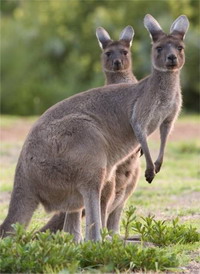Login form
Kangaroos
 If you shouted “Hey, Joey!” at a zoo in Australia, people might think you were talking to a kangaroo. Joey is the name for a baby kangaroo. If you think that is interesting, there are some other things you should know about kangaroos.
If you shouted “Hey, Joey!” at a zoo in Australia, people might think you were talking to a kangaroo. Joey is the name for a baby kangaroo. If you think that is interesting, there are some other things you should know about kangaroos.
Kangaroos are a special kind of mammal called a marsupial. Baby marsupials must live in a pouch on their mother’s abdomen. They have to live in the pouch because they are not fully developed when they are born. Ordinary mammals give birth to developed young with eyes, noses, inner organs, and limbs. Baby kangaroos have to finish their development in the pouch.
Kangaroos live only in Australia and New Guinea. Some live on grassy plains. Some live in forests. Some even live on golf courses.
WHAT KANGAROOS LOOK LIKE
There are more than 50 kinds of kangaroo. Large kangaroos include red kangaroos, gray kangaroos, wallabies, pademelons, and quokkas. Smaller kangaroos include rat-kangaroos, bettongs, and potoroos. The gray kangaroo and the red kangaroo are the largest kangaroos. They can stand as tall as 6.5 feet (2 meters) and weigh as much as 187 pounds (85 kilograms). The smallest kangaroos are the musky rat-kangaroos. They have long tails like rats. Rat-kangaroos are as small as 12 inches (30 centimeters), not including the tail.
Most kangaroo species have big ears and small heads. Kangaroos are covered with fur. Their fur is usually brown or gray. The male red kangaroo is reddish, but the female is grayish. Many kangaroos are a dull color to match their surroundings and help them hide from enemies.
Kangaroos have small front feet with five toes each. They have huge back feet with four toes. One of the toes on each hind foot has a sharp claw that the kangaroo uses to defend itself.
HOW KANGAROOS MOVE
Kangaroos use their big hind legs and thick tail for hopping. The hind legs of the red kangaroo are about ten times the size of the small front legs. Kangaroos use all four legs when they move slowly. When they need to move fast, they rise up on their hind legs and start hopping.
Some kangaroos can leap really far. Red kangaroos moving at top speeds can spring 16 feet (5 meters) or more in a single hop. They can hop at more than 31 miles per hour (50 kilometers per hour) for short periods of time. The kangaroo uses its tail for balance when it hops. It uses the tail for support when it sits.
The only kangaroo that does not hop is the musky rat-kangaroo.
WHAT DO KANGAROOS EAT?
Most kangaroos eat plants. Red kangaroos and gray kangaroos graze on grasses and other plants in forests and savannas (plains). The swamp wallaby, tree kangaroo, wallaroo, and other medium-size kangaroos eat leaves, shoots, and twigs in the forests where they live. Small kangaroos, such as rat-kangaroos and bettongs, eat both plants and small animals.
Kangaroos can digest plant material that is high in fiber and low in protein. Like cows and other hoofed animals, kangaroos have stomachs with several chambers. Bacteria in the chambers break down the plant material.
HOW ARE JOEYS BORN?
A female kangaroo usually gives birth once a year. All kangaroos except the musky rat-kangaroo have one joey. The musky rat-kangaroo usually has two. Some kangaroo species living in dry regions mate whenever there is enough food and water. These kangaroos may have no litters for several years if there is a drought.
A baby kangaroo is still undeveloped when it is born. The tiny animal weighs about 0.04 ounce (1 gram). It has no hair and cannot see. It crawls along its mother's body and into the pouch. Once inside, the baby attaches to a nipple and sucks milk. It stays in the pouch for several months. Even after the joey can move about on its own, it may stay with its mother until it is more than a year old.
Large kangaroos live from 12 to 18 years in the wild. They do not live as long if there is a long drought. In captivity with plenty of food and water, large kangaroos can live up to 28 years. Smaller kangaroos have shorter lives.
Source: Microsoft ® Encarta

